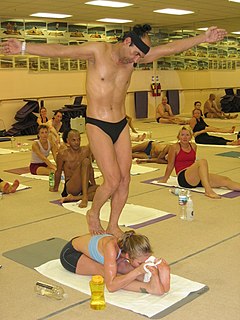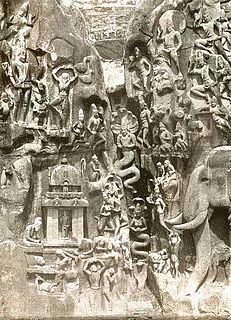 W
WYoga as exercise is a physical activity consisting mainly of postures, often connected by flowing sequences, sometimes accompanied by breathing exercises, and frequently ending with relaxation lying down or meditation. Yoga in this form has become familiar across the world, especially in America and Europe. It is derived from the postures used in the medieval spiritual discipline of Haṭha yoga, but it is generally simply called "yoga". Academics have given yoga as exercise a variety of names, including modern postural yoga and transnational anglophone yoga.
 W
WAn asana is a body posture, originally and still a general term for a sitting meditation pose, and later extended in hatha yoga and modern yoga as exercise, to any type of pose or position, adding reclining, standing, inverted, twisting, and balancing poses. The Yoga Sutras of Patanjali define "asana" as "[a position that] is steady and comfortable". Patanjali mentions the ability to sit for extended periods as one of the eight limbs of his system. Asanas are also called yoga poses or yoga postures in English.
 W
WAn asana is a posture, whether for traditional hatha yoga or for modern yoga; the term is derived from the Sanskrit word for 'seat'. While many of the oldest mentioned asanas are indeed seated postures for meditation, asanas may be standing, seated, arm-balances, twists, inversions, forward bends, backbends, or reclining in prone or supine positions. The asanas have been given a variety of English names by competing schools of yoga.
 W
WThe popularity of yoga as exercise has led to the creation of hybrid activities combining the practice of yoga asanas with other forms of exercise, the use of animals including dogs and horses, and other types of recreation.
 W
WPostural yoga began in India as a variant of traditional yoga, which was a mainly meditational practice; it has spread across the world and returned to the Indian subcontinent in different forms. The ancient Yoga Sutras of Patanjali mention yoga postures, asanas, only briefly, as meditation seats. Medieval Haṭha yoga made use of a small number of asanas alongside other techniques such as pranayama, shatkarmas, and mudras, but it was despised and almost extinct by the start of the 20th century. At that time, the revival of postural yoga was at first driven by Indian nationalism. Advocates such as Yogendra and Kuvalayananda made yoga acceptable in the 1920s, treating it as a medical subject. From the 1930s, the "father of modern yoga" Krishnamacharya developed a vigorous postural yoga, influenced by gymnastics, with transitions (vinyasas) that allowed one pose to flow into the next.
 W
WSexual abuse by yoga gurus is the exploitation of the position of trust occupied by a master of any branch of yoga for personal sexual pleasure. Allegations of such abuse have been made against gurus in international yoga as exercise such as Bikram Choudhury, John Friend, Kausthub Desikachar, Amrit Desai, and K. Pattabhi Jois. There have been some criminal convictions and lawsuits for civil damages.
 W
WThe standing asanas are the yoga poses or asanas with one or both feet on the ground, and the body more or less upright. They are among the most distinctive features of modern yoga as exercise. Until the 20th century there were very few of these, the best example being Vrikshasana, Tree Pose. From the time of Krishnamacharya in Mysore, many standing poses have been created. Two major sources of these asanas have been identified: the exercise sequence Surya Namaskar ; and the gymnastics widely practised in India at the time, based on the prevailing physical culture.
 W
WThe Story of Yoga: From Ancient India to the Modern West is a cultural history of yoga by Alistair Shearer. It narrates how an ancient spiritual practice in India became a global method of exercise, often with no spiritual content, by way of diverse movements including Indian nationalism, the Theosophical Society, Swami Vivekananda's coming to the west, self-publicising western yogis, Indian muscle builders, Krishnamacharya's practice in Mysore, and pioneering teachers like B. K. S. Iyengar.
 W
WSurya Namaskar, Salute to the Sun or Sun Salutation, is a practice in yoga as exercise incorporating a flow sequence of some twelve gracefully linked asanas. The asana sequence was first recorded as yoga in the early 20th century, though similar exercises were in use in India before that, for example among wrestlers. The basic sequence involves moving from a standing position into Downward and Upward Dog poses and then back to the standing position, but many variations are possible. The set of 12 asanas is dedicated to the solar deity Surya. In some Indian traditions, the positions are each associated with a different mantra.
 W
WModern yoga as exercise has often been taught by women to classes consisting mainly of women. This continued a tradition of gendered physical activity dating back to the early 20th century, with the Harmonic Gymnastics of Genevieve Stebbins in America and Mary Bagot Stack in Britain. One of the pioneers of modern yoga, Indra Devi, a pupil of Krishnamacharya, popularised yoga among American women using her celebrity Hollywood clients as a lever.
 W
WYoga mats are specially fabricated mats used to prevent hands and feet slipping during asana practice in modern yoga as exercise. An early variety made of rubber carpet underlay, pioneered by the yoga teacher Angela Farmer in 1982, was called a sticky mat.
 W
WYoga tourism is travel with the specific purpose of experiencing some form of yoga, whether spiritual or postural. The former is a type of spiritual tourism; the latter is related both to spiritual and to wellness tourism. Yoga tourists often visit ashrams in India to study yoga or to be trained and certified as yoga teachers. Major centres for yoga tourism include Rishikesh and Mysore.
 W
WProps such as chairs, blocks, belts, blankets and bolsters are used in postural yoga to assist with correct alignment in an asana, and to enable people with movement restricted for any reason, such as stiffness, injury, or arthritis, to continue with their practice.